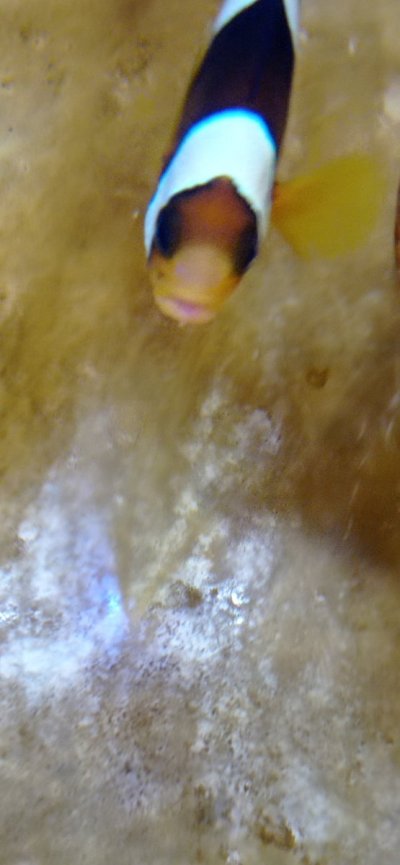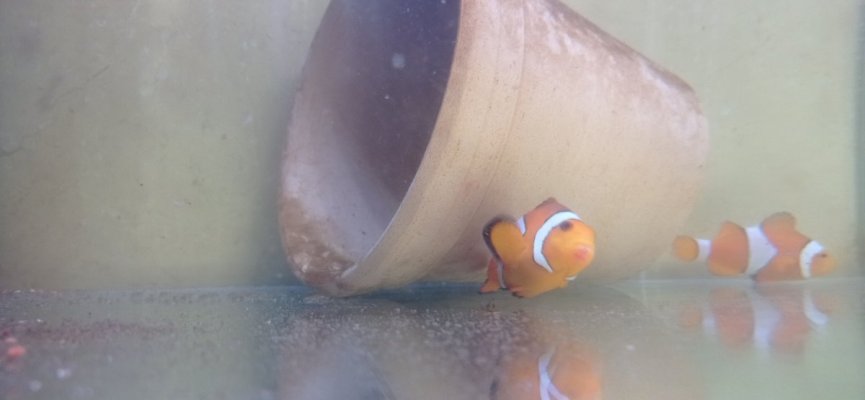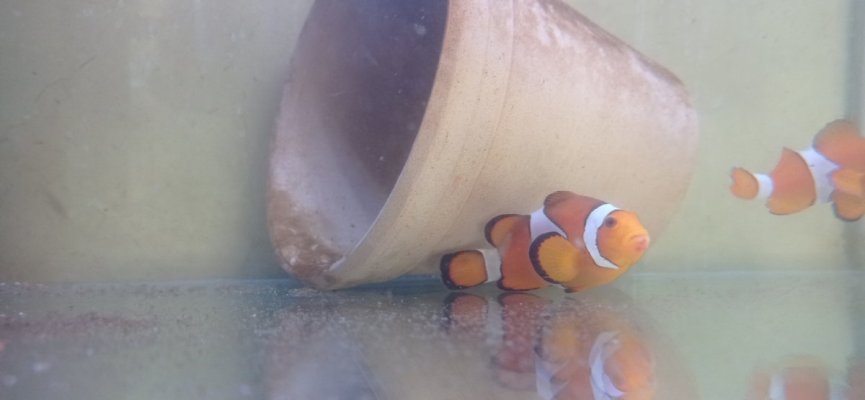Internal Diseases
Cause(s)
A variety of organisms can infect fish internally. Most are worms, a few are protozoans, and there is even an eel that infects the heart of living sharks! Some species have complicated life cycles with intermediate hosts, and others can directly infect fish.
Nematodes can infect the gut of fish, causing very serious infections. In severe infections, they can migrate out of the gut and attack other organs. Tapeworms (cestodes) may also be present but do not reproduce without a second host, so they are rarely a problem. Gut protozoans, such as Hexamita, are normally present in most fish but sometimes cause disease when their populations grow as a result of the fish’s immune response being limited by some stress factor.
Hexamita was once implicated in causing head and lateral line erosion, but its presence in the guts of fish with HLLE was purely coincidental. If non-infected fish had been examined, Hexamita would have been found in them as well.
Sporozoans, such as myxosporidians, can internally infect fish. Myxobolus cerebralis is a parasite of salmonids (salmon and trout) that causes whirling disease. At least two species of myxosporidian fish parasites require a worm as an intermediary host. Henneguya salminicola is another species that infects salmonids. Infected fish have numerous large white cysts (up to 1 cm) in their skeletal muscle. When ruptured, the cysts release a white liquid filled with tiny myxozoan spores (~10 µm). No doubt, these parasites are well-known in salmonids due to their economic impact. It is presumed that other fish have similar myxosporidian infections but are just less studied. There is no treatment for myxosporian infections, but luckily, they are a relatively rare affliction in aquarium fishes.
Microsporidians were once thought to be protozoans but are now considered more closely related to fungi. They are obligate intracellular parasites, and create lesions called xenomas. One of the more commonly seen, called Glugea, creates white, smooth masses inside and outside of infected fish. Some people may mistake these growths for Cryptocaryon, but any spot that stays in the same position on a fish for more than a few days is not Cryptocaryon. Pseudoloma neurophilia is a common microsporidian pathogen found in zebrafish (Danio rerio) in research facilities. It causes emaciation and skeletal deformities, and thus may be confused with the symptoms of Mycobacterium sp. infections. There is no routine treatment for these diseases but borrowing from a treatment used to control Nosema infections in honeybees, one experimental treatment has been proposed: Fumagillin DCH administered in food, at 0.1 g/kg food at 1.5% body weight daily ration for four weeks. This seemed to prevent mortalities in one report.
One commonly seen microsporidian in tropical freshwater aquariums is “neon tetra disease” Pleistophora hyphessobryconis. Infecting not only neons, but other tetras and cyprinids, it is not directly treatable. Ironically, the similar-looking cardinal tetra, Paracheirodon axelrodi, appears to be mostly immune to this disease. Symptoms vary, but include whitening of the muscles of the fish, especially near the caudal peduncle, as well as white slimy patches on the skin (which can mimic Columnaris disease). Other symptoms can include overall “tattered” look, emaciation and pale coloration. Pleistophora is thought to transfer between fish when dead fish are cannibalized by others. Keeping the aquarium clean and promptly removing any dead fish may help control the spread of this disease.
Heterosporis sp. is another group of microsporidians. They occur within the skeletal muscle cells of fish, where it creates sporophorocysts up to 200 µm in diameter. New spores, 7-10 µm across grow inside vesicles found inside the sporophorocysts. Muscle tissue turns opaque and cloudy in affected fish, sometimes appearing granular. In gamefish, this makes the flesh unappetizing to anglers. This microsporidian group has been isolated from a wide range of freshwater fishes, including many aquarium species; angelfish (Pterophyllum scalare), Betta (Betta splendens), Loricariid catfish and Cichlids. Currently, there is no known treatment, and the level of morbidity seen in various fish is unknown. If a necropsy is not performed, infections will not be identified. Even with a necropsy, focus is generally made on internal organs, skin and gills, so sporophorocysts in the muscles can easily be missed.
Symptoms
Symptoms of internal parasites, like the causative organisms themselves, are varied. The most important visual symptom is emaciation—abnormal thinness of the fish’s belly and the nape (behind the head). If this is present and the fish is feeding well, then internal parasites of the gut may be competing for that food with the fish. Other symptoms include white, stringy feces and bloating of the abdomen.
Diagnosis
Internal parasites are extremely difficult to diagnose visually based on symptoms alone. As with bacterial infections (which are too small to see without high powered microscopes and cellular staining), these internal infections are often attributed to any problem in a fish that involves mucus being excreted with feces. Also, abnormal thinness can often be attributed to the fish not feeding well in the first place—it may be a species that does not feed well on normal aquarium fare and has no internal worms at all.
Looking at a fecal sample under a microscope may help with diagnosis but understand that any fecal matter deposited in an aquarium will become contaminated with all sorts of free-living protozoans and metazoans in a matter of an hour or so. If possible, collect a fish’s feces while it is being held in a clean container.
Treatment options
Wait out “self-limiting” parasites
As alluded to above, many internal parasites require additional hosts to complete their life cycle. In aquariums, these hosts are almost never present, so the disease is considered “self-limiting.” That is, once the adult parasite dies, the fish is free of the disease because no new parasites are being produced. In other
words, the “parasite load” never gets any higher than when the fish arrived in your aquarium. In such cases (like tapeworm infections), it is safest to just wait out the infection.
Some internal parasites have direct development; they do not need a secondary host and may not even need to leave the fish in order to complete their life cycle. These parasites, such as some nematodes, can become very serious infections and must be treated if possible.
Medicated foods
Medicated foods would seem to be the favored treatment option, but all are dosed as a percent of medication in the food, fed to the fish at a rate that is a proportion of the fish’s body weight. The trouble, of course, is that few aquarists know the weight of their fish.
Avoid the advice to soak the fish’s food with medication. This can never work except by pure luck. Think about it; nobody knows how much of the medication actually soaks into the food (if any), and then, since you don’t know the weight of the fish, the amount of food to feed is just a guess.
Garlic
One treatment that has found much favor with home aquarists is the use of garlic as a food additive. It is relatively non-toxic, so dosage errors are not dangerous to the fish. However, it is more of an “irritant” to internal parasites in the gut, dislodging some, but not all of them. Additionally, it does not seem to have any effect on internal parasites that have migrated out of the gut (such as some nematode worms). Its use
should be considered an adjunct therapy as opposed to a medical treatment. The amount of garlic to be used is not well defined, but there are commercial products available to use for soaking food. In some cases, people have over-extrapolated the benefit of garlic and use it to treat external parasites. There is little evidence that garlic as a food additive can control acute external parasitic infections.
Medicating the water
Since, by definition, these parasites are internal, external bath medications won’t easily reach them. However, marine fish do “drink” water in order to help maintain a proper osmotic balance, so medications added to the water itself do end up inside the fish—but at an unknown dosage. A typical marine teleost will drink on the order of 10–20% of their body weight per day, with the ability to drink up to 35–40% if the salinity is high. For example, a fish weighing 500 g will consume around 100 mL of saltwater in a day. It could then be possible to calculate how much medication is swallowed by a fish in 24 hours.
There is some anecdotal evidence that Praziquantel, dosed at 2.2 to 4 mg/l, can help eliminate internal parasites in marine fish. Dosing the water of a freshwater aquarium will not work to treat internal diseases of those fish as they do not ingest water, so none of the medication would be taken it via that route. Medicated food is a better choice for treating freshwater fishes for gut parasites.
Cause(s)
A variety of organisms can infect fish internally. Most are worms, a few are protozoans, and there is even an eel that infects the heart of living sharks! Some species have complicated life cycles with intermediate hosts, and others can directly infect fish.
Nematodes can infect the gut of fish, causing very serious infections. In severe infections, they can migrate out of the gut and attack other organs. Tapeworms (cestodes) may also be present but do not reproduce without a second host, so they are rarely a problem. Gut protozoans, such as Hexamita, are normally present in most fish but sometimes cause disease when their populations grow as a result of the fish’s immune response being limited by some stress factor.
Hexamita was once implicated in causing head and lateral line erosion, but its presence in the guts of fish with HLLE was purely coincidental. If non-infected fish had been examined, Hexamita would have been found in them as well.
Sporozoans, such as myxosporidians, can internally infect fish. Myxobolus cerebralis is a parasite of salmonids (salmon and trout) that causes whirling disease. At least two species of myxosporidian fish parasites require a worm as an intermediary host. Henneguya salminicola is another species that infects salmonids. Infected fish have numerous large white cysts (up to 1 cm) in their skeletal muscle. When ruptured, the cysts release a white liquid filled with tiny myxozoan spores (~10 µm). No doubt, these parasites are well-known in salmonids due to their economic impact. It is presumed that other fish have similar myxosporidian infections but are just less studied. There is no treatment for myxosporian infections, but luckily, they are a relatively rare affliction in aquarium fishes.
Microsporidians were once thought to be protozoans but are now considered more closely related to fungi. They are obligate intracellular parasites, and create lesions called xenomas. One of the more commonly seen, called Glugea, creates white, smooth masses inside and outside of infected fish. Some people may mistake these growths for Cryptocaryon, but any spot that stays in the same position on a fish for more than a few days is not Cryptocaryon. Pseudoloma neurophilia is a common microsporidian pathogen found in zebrafish (Danio rerio) in research facilities. It causes emaciation and skeletal deformities, and thus may be confused with the symptoms of Mycobacterium sp. infections. There is no routine treatment for these diseases but borrowing from a treatment used to control Nosema infections in honeybees, one experimental treatment has been proposed: Fumagillin DCH administered in food, at 0.1 g/kg food at 1.5% body weight daily ration for four weeks. This seemed to prevent mortalities in one report.
One commonly seen microsporidian in tropical freshwater aquariums is “neon tetra disease” Pleistophora hyphessobryconis. Infecting not only neons, but other tetras and cyprinids, it is not directly treatable. Ironically, the similar-looking cardinal tetra, Paracheirodon axelrodi, appears to be mostly immune to this disease. Symptoms vary, but include whitening of the muscles of the fish, especially near the caudal peduncle, as well as white slimy patches on the skin (which can mimic Columnaris disease). Other symptoms can include overall “tattered” look, emaciation and pale coloration. Pleistophora is thought to transfer between fish when dead fish are cannibalized by others. Keeping the aquarium clean and promptly removing any dead fish may help control the spread of this disease.
Heterosporis sp. is another group of microsporidians. They occur within the skeletal muscle cells of fish, where it creates sporophorocysts up to 200 µm in diameter. New spores, 7-10 µm across grow inside vesicles found inside the sporophorocysts. Muscle tissue turns opaque and cloudy in affected fish, sometimes appearing granular. In gamefish, this makes the flesh unappetizing to anglers. This microsporidian group has been isolated from a wide range of freshwater fishes, including many aquarium species; angelfish (Pterophyllum scalare), Betta (Betta splendens), Loricariid catfish and Cichlids. Currently, there is no known treatment, and the level of morbidity seen in various fish is unknown. If a necropsy is not performed, infections will not be identified. Even with a necropsy, focus is generally made on internal organs, skin and gills, so sporophorocysts in the muscles can easily be missed.
Symptoms
Symptoms of internal parasites, like the causative organisms themselves, are varied. The most important visual symptom is emaciation—abnormal thinness of the fish’s belly and the nape (behind the head). If this is present and the fish is feeding well, then internal parasites of the gut may be competing for that food with the fish. Other symptoms include white, stringy feces and bloating of the abdomen.
Diagnosis
Internal parasites are extremely difficult to diagnose visually based on symptoms alone. As with bacterial infections (which are too small to see without high powered microscopes and cellular staining), these internal infections are often attributed to any problem in a fish that involves mucus being excreted with feces. Also, abnormal thinness can often be attributed to the fish not feeding well in the first place—it may be a species that does not feed well on normal aquarium fare and has no internal worms at all.
Looking at a fecal sample under a microscope may help with diagnosis but understand that any fecal matter deposited in an aquarium will become contaminated with all sorts of free-living protozoans and metazoans in a matter of an hour or so. If possible, collect a fish’s feces while it is being held in a clean container.
Treatment options
Wait out “self-limiting” parasites
As alluded to above, many internal parasites require additional hosts to complete their life cycle. In aquariums, these hosts are almost never present, so the disease is considered “self-limiting.” That is, once the adult parasite dies, the fish is free of the disease because no new parasites are being produced. In other
words, the “parasite load” never gets any higher than when the fish arrived in your aquarium. In such cases (like tapeworm infections), it is safest to just wait out the infection.
Some internal parasites have direct development; they do not need a secondary host and may not even need to leave the fish in order to complete their life cycle. These parasites, such as some nematodes, can become very serious infections and must be treated if possible.
Medicated foods
Medicated foods would seem to be the favored treatment option, but all are dosed as a percent of medication in the food, fed to the fish at a rate that is a proportion of the fish’s body weight. The trouble, of course, is that few aquarists know the weight of their fish.
Avoid the advice to soak the fish’s food with medication. This can never work except by pure luck. Think about it; nobody knows how much of the medication actually soaks into the food (if any), and then, since you don’t know the weight of the fish, the amount of food to feed is just a guess.
Garlic
One treatment that has found much favor with home aquarists is the use of garlic as a food additive. It is relatively non-toxic, so dosage errors are not dangerous to the fish. However, it is more of an “irritant” to internal parasites in the gut, dislodging some, but not all of them. Additionally, it does not seem to have any effect on internal parasites that have migrated out of the gut (such as some nematode worms). Its use
should be considered an adjunct therapy as opposed to a medical treatment. The amount of garlic to be used is not well defined, but there are commercial products available to use for soaking food. In some cases, people have over-extrapolated the benefit of garlic and use it to treat external parasites. There is little evidence that garlic as a food additive can control acute external parasitic infections.
Medicating the water
Since, by definition, these parasites are internal, external bath medications won’t easily reach them. However, marine fish do “drink” water in order to help maintain a proper osmotic balance, so medications added to the water itself do end up inside the fish—but at an unknown dosage. A typical marine teleost will drink on the order of 10–20% of their body weight per day, with the ability to drink up to 35–40% if the salinity is high. For example, a fish weighing 500 g will consume around 100 mL of saltwater in a day. It could then be possible to calculate how much medication is swallowed by a fish in 24 hours.
There is some anecdotal evidence that Praziquantel, dosed at 2.2 to 4 mg/l, can help eliminate internal parasites in marine fish. Dosing the water of a freshwater aquarium will not work to treat internal diseases of those fish as they do not ingest water, so none of the medication would be taken it via that route. Medicated food is a better choice for treating freshwater fishes for gut parasites.

























